Deck 24: Life
Question
Question
Question
Question
Question
Question
Question
Question
Question
Question
Question
Question
Question
Question
Question
Question
Question
Question
Question
Question
Question
Question
Question
Question
Question
Question
Question
Question
Question
Question
Question
Question
Question
Question
Question
Question
Question
Question
Question
Question
Question
Question
Question
Question
Question
Question
Question
Question
Question
Question
Question
Question
Question
Question
Question
Question
Question
Question
Question
Question
Question
Question
Question
Question
Question
Question
Question
Question
Question
Question
Question
Question
Question
Question
Question
Question
Question
Question
Question
Question

Unlock Deck
Sign up to unlock the cards in this deck!
Unlock Deck
Unlock Deck
1/100
Play
Full screen (f)
Deck 24: Life
1
Natural selection essentially implies the ability to
A) pass on a genetic code to the next generation.
B) avoid interaction with the environment.
C) self-replicate.
D) adapt to environmental changes.
E) avoid genetic mutations.
A) pass on a genetic code to the next generation.
B) avoid interaction with the environment.
C) self-replicate.
D) adapt to environmental changes.
E) avoid genetic mutations.
adapt to environmental changes.
2
The "waste" product in the process of photosynthesis is
A) sugar.
B) carbon dioxide.
C) oxygen.
D) amino acids.
E) carbohydrates.
A) sugar.
B) carbon dioxide.
C) oxygen.
D) amino acids.
E) carbohydrates.
oxygen.
3
The earliest life-forms on Earth likely appeared
A) within a billion years after the formation of the Solar System.
B) 3.65 billion years after the formation of the Solar System.
C) 4.6 billion years ago.
D) 250 million years ago.
E) 20 million years ago.
A) within a billion years after the formation of the Solar System.
B) 3.65 billion years after the formation of the Solar System.
C) 4.6 billion years ago.
D) 250 million years ago.
E) 20 million years ago.
within a billion years after the formation of the Solar System.
4
The evolution of terrestrial life involves which of the following?
A) mechanisms of change
B) mutation
C) heredity
D) natural selection
E) all of these
A) mechanisms of change
B) mutation
C) heredity
D) natural selection
E) all of these

Unlock Deck
Unlock for access to all 100 flashcards in this deck.
Unlock Deck
k this deck
5
The image below shows an Australian shoreline.Which of the following forms of early life on Earth does it illustrate? 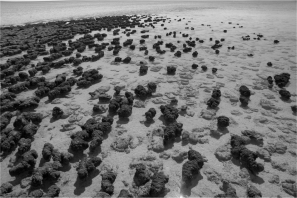
A) stromatolites
B) fish colonies
C) eukaryotes
D) meteorites
E) fungi

A) stromatolites
B) fish colonies
C) eukaryotes
D) meteorites
E) fungi

Unlock Deck
Unlock for access to all 100 flashcards in this deck.
Unlock Deck
k this deck
6
One general property of living organisms is that they
A) modify their environment.
B) require direct sunlight to exist.
C) do not necessarily require food or sustenance.
D) can be found at any possible temperature.
E) only require the chemical elements created during the Big Bang.
A) modify their environment.
B) require direct sunlight to exist.
C) do not necessarily require food or sustenance.
D) can be found at any possible temperature.
E) only require the chemical elements created during the Big Bang.

Unlock Deck
Unlock for access to all 100 flashcards in this deck.
Unlock Deck
k this deck
7
What makes molecules organic?
A) They can reproduce.
B) They are very complex.
C) They are unique to Earth.
D) They need oxygen to form.
E) They contain carbon.
A) They can reproduce.
B) They are very complex.
C) They are unique to Earth.
D) They need oxygen to form.
E) They contain carbon.

Unlock Deck
Unlock for access to all 100 flashcards in this deck.
Unlock Deck
k this deck
8
Animals are most closely related to which of the following evolutionary branches?
A) bacteria
B) archaea
C) flagellates
D) fungi
E) cyanobacteria
A) bacteria
B) archaea
C) flagellates
D) fungi
E) cyanobacteria

Unlock Deck
Unlock for access to all 100 flashcards in this deck.
Unlock Deck
k this deck
9
Heredity essentially implies the ability to
A) pass on a genetic code to the next generation.
B) avoid interaction with the environment.
C) divide exponentially.
D) adapt to environmental changes.
E) avoid genetic mutations.
A) pass on a genetic code to the next generation.
B) avoid interaction with the environment.
C) divide exponentially.
D) adapt to environmental changes.
E) avoid genetic mutations.

Unlock Deck
Unlock for access to all 100 flashcards in this deck.
Unlock Deck
k this deck
10
At approximately what fraction of the Earth's current age did the first humans branch out from chimpanzees?
A) > 99%
B) 98%
C) 90%
D) 20%
E) 5%
A) > 99%
B) 98%
C) 90%
D) 20%
E) 5%

Unlock Deck
Unlock for access to all 100 flashcards in this deck.
Unlock Deck
k this deck
11
In 1952, chemists Harold Urey and Stanley Miller mixed ammonia, methane, and hydrogen in a closed container, zapped it with electrical sparks, and found that
A) they could induce cold fusion.
B) amino acids cannot form this way.
C) single-celled microorganisms had been spontaneously created.
D) amino acids had been created.
E) they had created life in a test tube.
A) they could induce cold fusion.
B) amino acids cannot form this way.
C) single-celled microorganisms had been spontaneously created.
D) amino acids had been created.
E) they had created life in a test tube.

Unlock Deck
Unlock for access to all 100 flashcards in this deck.
Unlock Deck
k this deck
12
What was the goal of the Urey-Miller experiment schematized in the figure below? 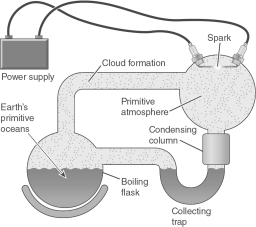
A) to create a microorganism
B) to simulate the formation of Earth
C) to simulate the Big Bang
D) to simulate the early universe
E) to simulate the formation of the building blocks of life

A) to create a microorganism
B) to simulate the formation of Earth
C) to simulate the Big Bang
D) to simulate the early universe
E) to simulate the formation of the building blocks of life

Unlock Deck
Unlock for access to all 100 flashcards in this deck.
Unlock Deck
k this deck
13
Which of the following is an example of an extremophile?
A) organisms that thrive at high temperatures
B) organisms that thrive without light
C) organisms that thrive in highly acidic environments
D) organisms that thrive in environments with high radiation levels
E) All of these are examples of extremophiles.
A) organisms that thrive at high temperatures
B) organisms that thrive without light
C) organisms that thrive in highly acidic environments
D) organisms that thrive in environments with high radiation levels
E) All of these are examples of extremophiles.

Unlock Deck
Unlock for access to all 100 flashcards in this deck.
Unlock Deck
k this deck
14
Which of the following properties would be a unique marker of life, as compared to other natural processes?
A) patterned structure
B) self-replication
C) utilizing energy from an environment
D) growing in size with time
E) evolutionary adaptation
A) patterned structure
B) self-replication
C) utilizing energy from an environment
D) growing in size with time
E) evolutionary adaptation

Unlock Deck
Unlock for access to all 100 flashcards in this deck.
Unlock Deck
k this deck
15
The ability for one generation to pass on its characteristics to future generations is known as
A) natural selection.
B) mutation.
C) heredity.
D) division.
E) duplication.
A) natural selection.
B) mutation.
C) heredity.
D) division.
E) duplication.

Unlock Deck
Unlock for access to all 100 flashcards in this deck.
Unlock Deck
k this deck
16
The current oxygen level in the Earth's atmosphere was reached about
A) 4.6 billion years ago.
B) 2 billion years ago.
C) 20 million years ago.
D) 250 million years ago.
E) 540 million years ago.
A) 4.6 billion years ago.
B) 2 billion years ago.
C) 20 million years ago.
D) 250 million years ago.
E) 540 million years ago.

Unlock Deck
Unlock for access to all 100 flashcards in this deck.
Unlock Deck
k this deck
17
In order to survive, humans require a minimum of one-third of the oxygen content at sea level.Using the figure below, what was the most recent point in Earth's history at which a human could (barely) survive unaided on the surface? 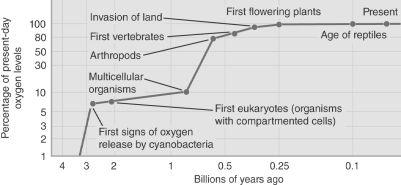
A) 250 million years ago
B) 600 million years ago
C) 1 billion years ago
D) 3 billion years ago
E) 10 billion years ago.

A) 250 million years ago
B) 600 million years ago
C) 1 billion years ago
D) 3 billion years ago
E) 10 billion years ago.

Unlock Deck
Unlock for access to all 100 flashcards in this deck.
Unlock Deck
k this deck
18
In which of the following locations has life been found on Earth?
A) near deep-ocean hydrothermal vents
B) in extremely dry deserts
C) in arctic ice
D) in hot sulfur springs
E) Life has been found in all of these locations.
A) near deep-ocean hydrothermal vents
B) in extremely dry deserts
C) in arctic ice
D) in hot sulfur springs
E) Life has been found in all of these locations.

Unlock Deck
Unlock for access to all 100 flashcards in this deck.
Unlock Deck
k this deck
19
As seen in the figure below, evolution allows 
A) life to diversify into different species.
B) a species to revert to an earlier species, if beneficial.
C) organisms to become more complicated, but not more diverse.
D) different species to merge into one as time goes on.
E) organisms to become more diverse, but not more complex.

A) life to diversify into different species.
B) a species to revert to an earlier species, if beneficial.
C) organisms to become more complicated, but not more diverse.
D) different species to merge into one as time goes on.
E) organisms to become more diverse, but not more complex.

Unlock Deck
Unlock for access to all 100 flashcards in this deck.
Unlock Deck
k this deck
20
Adding hydrogen sulfide to the "primitive atmosphere" simulated in the Urey-Miller experiment simulated what process?
A) volcanic eruptions
B) atmospheric turbulence
C) asteroid and comet impacts
D) the passage of time
E) pollution due to human activity
A) volcanic eruptions
B) atmospheric turbulence
C) asteroid and comet impacts
D) the passage of time
E) pollution due to human activity

Unlock Deck
Unlock for access to all 100 flashcards in this deck.
Unlock Deck
k this deck
21
If a certain population of bacteria doubles itself every 10 minutes, how many times bigger will the population be after 1 hour?
A) We need to know the starting population in order to know.
B) 1
C) 6
D) 32
E) 64
A) We need to know the starting population in order to know.
B) 1
C) 6
D) 32
E) 64

Unlock Deck
Unlock for access to all 100 flashcards in this deck.
Unlock Deck
k this deck
22
Exponential growth generally describes a population
A) that has a constant rate of growth.
B) that doubles in size in an infinitesimally small fraction of a second.
C) that has virtually an infinite space available for growth.
D) that is not undergoing natural selection.
E) of silicon-based molecular structures.
A) that has a constant rate of growth.
B) that doubles in size in an infinitesimally small fraction of a second.
C) that has virtually an infinite space available for growth.
D) that is not undergoing natural selection.
E) of silicon-based molecular structures.

Unlock Deck
Unlock for access to all 100 flashcards in this deck.
Unlock Deck
k this deck
23
Imagine that you built a time machine and successfully traveled 2 billion years back in time. What would you observe, given our current understanding of Earth's history?
A) dinosaurs roaming Earth
B) forests and insects everywhere on Earth
C) the ongoing heavy bombardment of Earth
D) a severe scarcity of oxygen in the atmosphere
E) You would be floating in space because Earth hadn't formed yet.
A) dinosaurs roaming Earth
B) forests and insects everywhere on Earth
C) the ongoing heavy bombardment of Earth
D) a severe scarcity of oxygen in the atmosphere
E) You would be floating in space because Earth hadn't formed yet.

Unlock Deck
Unlock for access to all 100 flashcards in this deck.
Unlock Deck
k this deck
24
Complex microorganisms that have complex DNA enclosed in a cell nucleus are called
A) algae.
B) bacteria.
C) fungi.
D) eukaryotes.
E) prokaryotes.
A) algae.
B) bacteria.
C) fungi.
D) eukaryotes.
E) prokaryotes.

Unlock Deck
Unlock for access to all 100 flashcards in this deck.
Unlock Deck
k this deck
25
The atomic elements that make up the structure of the amino acids are
A) carbon, hydrogen, oxygen, nitrogen, and phosphorus.
B) carbon, hydrogen, oxygen, nitrogen, and sulfur.
C) sodium, chlorine, calcium, copper, zinc, and potassium.
D) zinc, iodine, iron, calcium, and carbon.
E) hydrogen, helium, carbon, nitrogen, and oxygen.
A) carbon, hydrogen, oxygen, nitrogen, and phosphorus.
B) carbon, hydrogen, oxygen, nitrogen, and sulfur.
C) sodium, chlorine, calcium, copper, zinc, and potassium.
D) zinc, iodine, iron, calcium, and carbon.
E) hydrogen, helium, carbon, nitrogen, and oxygen.

Unlock Deck
Unlock for access to all 100 flashcards in this deck.
Unlock Deck
k this deck
26
Why was the comet or asteroid impact 65 million years ago an event that benefited the evolution of humans?
A) It deposited a significant amount of nitrogen into Earth's atmosphere.
B) It led to an increase in global UV radiation, which killed off most of the forests and jungles.
C) Conditions became more favorable for mammalian life.
D) Plant life began to decline.
E) It brought human DNA to Earth.
A) It deposited a significant amount of nitrogen into Earth's atmosphere.
B) It led to an increase in global UV radiation, which killed off most of the forests and jungles.
C) Conditions became more favorable for mammalian life.
D) Plant life began to decline.
E) It brought human DNA to Earth.

Unlock Deck
Unlock for access to all 100 flashcards in this deck.
Unlock Deck
k this deck
27
It is hypothesized that both carbon and silicon could form the "backbone" of DNA.Using the figure below, which of the following scenarios might lead to a star system that has more silicon than carbon? 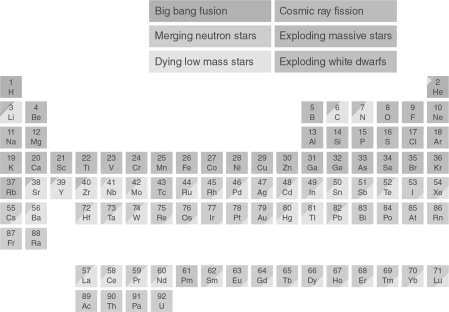
A) It formed in proximity to many high-mass stars, but few low-mass stars.
B) It formed near a large number of exploding white dwarf stars.
C) It formed near low-mass stars, but no high-mass stars.
D) It formed from "raw" material from the Big Bang.
E) It is a binary star system.

A) It formed in proximity to many high-mass stars, but few low-mass stars.
B) It formed near a large number of exploding white dwarf stars.
C) It formed near low-mass stars, but no high-mass stars.
D) It formed from "raw" material from the Big Bang.
E) It is a binary star system.

Unlock Deck
Unlock for access to all 100 flashcards in this deck.
Unlock Deck
k this deck
28
At approximately what fraction of the Earth's current age were the dinosaurs wiped out by a large asteroid or comet?
A) > 99%
B) 98%
C) 90%
D) 20%
E) 5%
A) > 99%
B) 98%
C) 90%
D) 20%
E) 5%

Unlock Deck
Unlock for access to all 100 flashcards in this deck.
Unlock Deck
k this deck
29
What is the major difference between prokaryotes and eukaryotes?
A) Eukaryotes have DNA, and prokaryotes have RNA.
B) Eukaryotes have a nuclear membrane surrounding their DNA, and prokaryotes do not.
C) Eukaryotes are plants, and prokaryotes are animals.
D) Eukaryotes appeared on Earth before prokaryotes.
E) Eukaryotes are single-celled, and prokaryotes are multicellular.
A) Eukaryotes have DNA, and prokaryotes have RNA.
B) Eukaryotes have a nuclear membrane surrounding their DNA, and prokaryotes do not.
C) Eukaryotes are plants, and prokaryotes are animals.
D) Eukaryotes appeared on Earth before prokaryotes.
E) Eukaryotes are single-celled, and prokaryotes are multicellular.

Unlock Deck
Unlock for access to all 100 flashcards in this deck.
Unlock Deck
k this deck
30
The most abundant elements manufactured by stars through nuclear reactions are
A) iron, silicon, carbon, and sulfur.
B) helium, carbon, nitrogen, and oxygen.
C) zinc, iodine, iron, calcium, and carbon.
D) carbon, hydrogen, oxygen, and phosphorus.
E) carbon, iron, lithium, and argon.
A) iron, silicon, carbon, and sulfur.
B) helium, carbon, nitrogen, and oxygen.
C) zinc, iodine, iron, calcium, and carbon.
D) carbon, hydrogen, oxygen, and phosphorus.
E) carbon, iron, lithium, and argon.

Unlock Deck
Unlock for access to all 100 flashcards in this deck.
Unlock Deck
k this deck
31
Which of the following occurred approximately 500 million years ago?
A) the extinction of the dinosaurs
B) the Cambrian explosion
C) the formation of the Moon
D) the rise of mammals
E) the birth of the first humans
A) the extinction of the dinosaurs
B) the Cambrian explosion
C) the formation of the Moon
D) the rise of mammals
E) the birth of the first humans

Unlock Deck
Unlock for access to all 100 flashcards in this deck.
Unlock Deck
k this deck
32
Which of the following events is the oldest in the history of life evolution on Earth?
A) the Cambrian explosion
B) the appearance of the first plants on land
C) the demise of the dinosaurs
D) the branching of primates away from other mammals
E) the first human civilizations
A) the Cambrian explosion
B) the appearance of the first plants on land
C) the demise of the dinosaurs
D) the branching of primates away from other mammals
E) the first human civilizations

Unlock Deck
Unlock for access to all 100 flashcards in this deck.
Unlock Deck
k this deck
33
Which of the following sequences correctly ranks the number of atoms in the human body from highest to lowest?
A) carbon, oxygen, nitrogen, silicon
B) carbon, oxygen, nitrogen, phosphorous
C) hydrogen, oxygen, carbon, nitrogen
D) hydrogen, oxygen, carbon, phosphorous
E) carbon, hydrogen, oxygen, nitrogen
A) carbon, oxygen, nitrogen, silicon
B) carbon, oxygen, nitrogen, phosphorous
C) hydrogen, oxygen, carbon, nitrogen
D) hydrogen, oxygen, carbon, phosphorous
E) carbon, hydrogen, oxygen, nitrogen

Unlock Deck
Unlock for access to all 100 flashcards in this deck.
Unlock Deck
k this deck
34
In the context of self-replication of molecules, if each of them is successfully copying itself every 2 minutes, how long does it take to have a population growth factor of the order of a billion?
A) 1 hour
B) 2 hours
C) 10 minutes
D) 2 minutes
E) 2 billion minutes
A) 1 hour
B) 2 hours
C) 10 minutes
D) 2 minutes
E) 2 billion minutes

Unlock Deck
Unlock for access to all 100 flashcards in this deck.
Unlock Deck
k this deck
35
Out of the chemical elements, the second-best candidate for enabling biological life-forms is
A) oxygen.
B) helium.
C) hydrogen.
D) silicon.
E) phosphorus.
A) oxygen.
B) helium.
C) hydrogen.
D) silicon.
E) phosphorus.

Unlock Deck
Unlock for access to all 100 flashcards in this deck.
Unlock Deck
k this deck
36
Carbon forms the backbone of our complex DNA structure primarily because
A) it is the most abundant element in the universe after hydrogen and helium.
B) it reacts easily with oxygen.
C) it remains solid even at high temperatures.
D) a carbon atom can bond with up to four other atoms at a time.
E) it can form multiple types of crystal structures.
A) it is the most abundant element in the universe after hydrogen and helium.
B) it reacts easily with oxygen.
C) it remains solid even at high temperatures.
D) a carbon atom can bond with up to four other atoms at a time.
E) it can form multiple types of crystal structures.

Unlock Deck
Unlock for access to all 100 flashcards in this deck.
Unlock Deck
k this deck
37
The chemical element that forms the "backbone" of DNA molecules is
A) carbon.
B) nitrogen.
C) silicon.
D) helium.
E) oxygen.
A) carbon.
B) nitrogen.
C) silicon.
D) helium.
E) oxygen.

Unlock Deck
Unlock for access to all 100 flashcards in this deck.
Unlock Deck
k this deck
38
At approximately what fraction of the Earth's current age did the first plants on land appear?
A) > 99%
B) 98%
C) 90%
D) 20%
E) 5%
A) > 99%
B) 98%
C) 90%
D) 20%
E) 5%

Unlock Deck
Unlock for access to all 100 flashcards in this deck.
Unlock Deck
k this deck
39
How did the presence of cyanobacteria on Earth in the past enable the later appearance of more advanced life-forms, such as humans?
A) They absorbed harmful chemicals, making the air safer.
B) They initiated the oxygenation of the atmosphere.
C) They fertilized the soil to let plants grow.
D) They increased the carbon dioxide in the atmosphere, causing the greenhouse effect.
E) They "ate" plants, creating the first digestive systems on Earth.
A) They absorbed harmful chemicals, making the air safer.
B) They initiated the oxygenation of the atmosphere.
C) They fertilized the soil to let plants grow.
D) They increased the carbon dioxide in the atmosphere, causing the greenhouse effect.
E) They "ate" plants, creating the first digestive systems on Earth.

Unlock Deck
Unlock for access to all 100 flashcards in this deck.
Unlock Deck
k this deck
40
The atomic elements that make up the structure of DNA are
A) carbon, hydrogen, oxygen, nitrogen, and phosphorus.
B) carbon, hydrogen, oxygen, nitrogen, and sulfur.
C) sodium, chlorine, calcium, copper, zinc, and potassium.
D) zinc, iodine, iron, calcium, and carbon.
E) hydrogen, helium, carbon, nitrogen, and oxygen.
A) carbon, hydrogen, oxygen, nitrogen, and phosphorus.
B) carbon, hydrogen, oxygen, nitrogen, and sulfur.
C) sodium, chlorine, calcium, copper, zinc, and potassium.
D) zinc, iodine, iron, calcium, and carbon.
E) hydrogen, helium, carbon, nitrogen, and oxygen.

Unlock Deck
Unlock for access to all 100 flashcards in this deck.
Unlock Deck
k this deck
41
If future exploration of the moons of Jupiter and Saturn discover primitive life-forms, it would imply a ________ probability of finding an advanced civilization somewhere else in the Milky
Way because ________.
A) higher; it shows that life can exist in environments that are very different from those found on Earth
B) higher; it would show that life can survive travel through space after leaving Earth
C) much lower; primitive life-forms have nothing to do with the existence of advanced civilizations
D) decreased; it would show that primitive life-forms outside Earth cannot evolve into more complex species
E) decreased; it would show that primitive life-forms are far more common than advanced ones
Way because ________.
A) higher; it shows that life can exist in environments that are very different from those found on Earth
B) higher; it would show that life can survive travel through space after leaving Earth
C) much lower; primitive life-forms have nothing to do with the existence of advanced civilizations
D) decreased; it would show that primitive life-forms outside Earth cannot evolve into more complex species
E) decreased; it would show that primitive life-forms are far more common than advanced ones

Unlock Deck
Unlock for access to all 100 flashcards in this deck.
Unlock Deck
k this deck
42
Which of the following is expected to be a strong requirement for supporting life?
A) tidal forces
B) photosynthesis
C) water in liquid form
D) an atmosphere
E) lightning strikes
A) tidal forces
B) photosynthesis
C) water in liquid form
D) an atmosphere
E) lightning strikes

Unlock Deck
Unlock for access to all 100 flashcards in this deck.
Unlock Deck
k this deck
43
The ability of a celestial body to retain an atmosphere would depend mainly on which of the following properties?
A) mass and size
B) age and composition
C) presence of life-forms on it
D) tilt of the axis of rotation
E) period of rotation
A) mass and size
B) age and composition
C) presence of life-forms on it
D) tilt of the axis of rotation
E) period of rotation

Unlock Deck
Unlock for access to all 100 flashcards in this deck.
Unlock Deck
k this deck
44
Given Earth's evolutionary timeline, what percent of Earth-like planets in a 2 billion-year-old star cluster can be estimated to host intelligent life?
A) 0 percent
B) 10 percent
C) 30 percent
D) 50 percent
E) 100 percent
A) 0 percent
B) 10 percent
C) 30 percent
D) 50 percent
E) 100 percent

Unlock Deck
Unlock for access to all 100 flashcards in this deck.
Unlock Deck
k this deck
45
Which of the following bodies of the Solar System shows the poorest evidence of water?
A) Mercury
B) Europa
C) Enceladus
D) Titan
E) Mars
A) Mercury
B) Europa
C) Enceladus
D) Titan
E) Mars

Unlock Deck
Unlock for access to all 100 flashcards in this deck.
Unlock Deck
k this deck
46
You find a planet orbiting an F-type star (surface temperature 6500 K).Where is this planet with respect to the habitable zone, if this planet has a circular orbit with a radius of 2.6 AU? The figure below may be helpful. 
A) not in the habitable zone (too hot)
B) on the hot edge of the habitable zone
C) right in the middle of the habitable zone
D) on the cold edge of the habitable zone
E) not in the habitable zone (too cold)

A) not in the habitable zone (too hot)
B) on the hot edge of the habitable zone
C) right in the middle of the habitable zone
D) on the cold edge of the habitable zone
E) not in the habitable zone (too cold)

Unlock Deck
Unlock for access to all 100 flashcards in this deck.
Unlock Deck
k this deck
47
What does "habitable zone around a star" mean in the current framework of the search for exoplanets?
A) the region around the star where the inhabitants of nearby planetary systems can safely visit
B) the region around the star where planetary temperatures would not be too hot or too cold for liquid water to exist
C) the region around the star where planets have icy moons
D) the region around the star where planets can form an atmosphere
E) the region around the star where intelligent civilizations are not exposed to harmful doses of radiation
A) the region around the star where the inhabitants of nearby planetary systems can safely visit
B) the region around the star where planetary temperatures would not be too hot or too cold for liquid water to exist
C) the region around the star where planets have icy moons
D) the region around the star where planets can form an atmosphere
E) the region around the star where intelligent civilizations are not exposed to harmful doses of radiation

Unlock Deck
Unlock for access to all 100 flashcards in this deck.
Unlock Deck
k this deck
48
If the Sun were colder and dimmer than it is, the planet closest to the middle of the habitable zone would be
A) Mars.
B) Saturn.
C) Venus.
D) Jupiter.
E) Ceres, in the asteroid belt.
A) Mars.
B) Saturn.
C) Venus.
D) Jupiter.
E) Ceres, in the asteroid belt.

Unlock Deck
Unlock for access to all 100 flashcards in this deck.
Unlock Deck
k this deck
49
The main goal of the Allen Telescope Array is to search for
A) silicon-based life-forms in other planetary systems.
B) electromagnetic signals from civilizations inhabiting habitable planets.
C) exoplanets in other galaxies.
D) dark energy.
E) man-made satellites drifting out of control around Earth.
A) silicon-based life-forms in other planetary systems.
B) electromagnetic signals from civilizations inhabiting habitable planets.
C) exoplanets in other galaxies.
D) dark energy.
E) man-made satellites drifting out of control around Earth.

Unlock Deck
Unlock for access to all 100 flashcards in this deck.
Unlock Deck
k this deck
50
The figure below is a photograph of the surface of Mars.In this image, we see rounded bits of gravel, which are evidence for 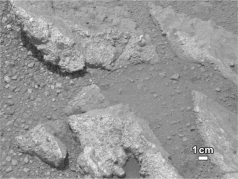
A) tectonic activity.
B) intelligent life-forms having ground down the rocks.
C) bacterial life having once lived in the surface of the gravel particles.
D) liquid having flowed on the surface in the past.
E) intense winds that could only occur in a thicker atmosphere.

A) tectonic activity.
B) intelligent life-forms having ground down the rocks.
C) bacterial life having once lived in the surface of the gravel particles.
D) liquid having flowed on the surface in the past.
E) intense winds that could only occur in a thicker atmosphere.

Unlock Deck
Unlock for access to all 100 flashcards in this deck.
Unlock Deck
k this deck
51
Based on what we know about the evolution of life on Earth, which of the planets shown in the figure below would be most likely to host an advanced civilization? 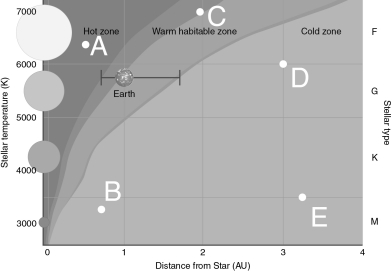
A) Planet A
B) Planet B
C) Planet C
D) Planet D
E) Planet E

A) Planet A
B) Planet B
C) Planet C
D) Planet D
E) Planet E

Unlock Deck
Unlock for access to all 100 flashcards in this deck.
Unlock Deck
k this deck
52
Which of the following bodies of the Solar System has not yet been landed upon by spacecraft?
A) Europa
B) Titan
C) the Moon
D) Mars
E) Venus
A) Europa
B) Titan
C) the Moon
D) Mars
E) Venus

Unlock Deck
Unlock for access to all 100 flashcards in this deck.
Unlock Deck
k this deck
53
The Solar System body to which humans have dedicated the largest number of landing missions so far is
A) Europa.
B) Titan.
C) Enceladus.
D) Mars.
E) Venus.
A) Europa.
B) Titan.
C) Enceladus.
D) Mars.
E) Venus.

Unlock Deck
Unlock for access to all 100 flashcards in this deck.
Unlock Deck
k this deck
54
What would be the main factors determining whether water can exist in a liquid state on the surface of a planet?
A) the presence of photosynthetic and highly intelligent life-forms
B) the age and mass of the central star
C) the atmospheric pressure and temperature on the planetary surface
D) the color and temperature of the central star
E) the existence of carbon-based biology
A) the presence of photosynthetic and highly intelligent life-forms
B) the age and mass of the central star
C) the atmospheric pressure and temperature on the planetary surface
D) the color and temperature of the central star
E) the existence of carbon-based biology

Unlock Deck
Unlock for access to all 100 flashcards in this deck.
Unlock Deck
k this deck
55
Planets that are close to their stars may lack the day/night cycle due to
A) having a large fraction of the sky covered by the stellar disk.
B) being tidally locked.
C) having short orbital periods.
D) lacking an atmosphere.
E) lacking moons.
A) having a large fraction of the sky covered by the stellar disk.
B) being tidally locked.
C) having short orbital periods.
D) lacking an atmosphere.
E) lacking moons.

Unlock Deck
Unlock for access to all 100 flashcards in this deck.
Unlock Deck
k this deck
56
Which of the following Solar System objects is LEAST likely to have, or have had, life?
A) Mars
B) Jupiter's moon Europa
C) Saturn's moon Titan
D) Venus
E) Saturn's moon Enceladus
A) Mars
B) Jupiter's moon Europa
C) Saturn's moon Titan
D) Venus
E) Saturn's moon Enceladus

Unlock Deck
Unlock for access to all 100 flashcards in this deck.
Unlock Deck
k this deck
57
The field of astrobiology uses our knowledge of ________ to study life in the universe.
A) biology
B) chemistry
C) physics
D) astronomy
E) all of these
A) biology
B) chemistry
C) physics
D) astronomy
E) all of these

Unlock Deck
Unlock for access to all 100 flashcards in this deck.
Unlock Deck
k this deck
58
The habitable zone for a 2MSUN star is ________ and covers a ________ distance range compared with the habitable zone for a 1MSUN star.
A) closer inward; narrower
B) further outward; narrower
C) further outward; wider
D) closer inward; the same
E) further outward; the same
A) closer inward; narrower
B) further outward; narrower
C) further outward; wider
D) closer inward; the same
E) further outward; the same

Unlock Deck
Unlock for access to all 100 flashcards in this deck.
Unlock Deck
k this deck
59
Why are high-mass stars not expected to have planets with advanced/intelligent life-forms?
A) High-mass stars are short-lived, hence evolution has less time to happen.
B) High-mass stars are too big, and their habitable zone is very narrow.
C) High-mass stars are too hot, and their habitable zone is too far from them.
D) High-mass stars are too blue, and intelligent life-forms can see only white light.
E) High-mass stars don't form planets around them.
A) High-mass stars are short-lived, hence evolution has less time to happen.
B) High-mass stars are too big, and their habitable zone is very narrow.
C) High-mass stars are too hot, and their habitable zone is too far from them.
D) High-mass stars are too blue, and intelligent life-forms can see only white light.
E) High-mass stars don't form planets around them.

Unlock Deck
Unlock for access to all 100 flashcards in this deck.
Unlock Deck
k this deck
60
Can more than one planet be found in the same habitable zone around a single star?
A) No, habitable zones are too small for more than one planet.
B) No, two planet orbits would not be stable inside the same habitable zone.
C) No, habitable zones are defined on a per-planet basis.
D) Yes, in theory, but this has not yet been observed.
E) Yes, and this has been observed.
A) No, habitable zones are too small for more than one planet.
B) No, two planet orbits would not be stable inside the same habitable zone.
C) No, habitable zones are defined on a per-planet basis.
D) Yes, in theory, but this has not yet been observed.
E) Yes, and this has been observed.

Unlock Deck
Unlock for access to all 100 flashcards in this deck.
Unlock Deck
k this deck
61
Currently the number of confirmed exoplanets is around
A) a dozen.
B) 2 million.
C) a few thousand.
D) a few hundred.
E) 50,000.
A) a dozen.
B) 2 million.
C) a few thousand.
D) a few hundred.
E) 50,000.

Unlock Deck
Unlock for access to all 100 flashcards in this deck.
Unlock Deck
k this deck
62
What determines whether a specific mutation is passed on to future generations?

Unlock Deck
Unlock for access to all 100 flashcards in this deck.
Unlock Deck
k this deck
63
How old is Earth? What was the age of Earth when each of the following occurred: microorganisms first formed; oxygen became a significant component of the atmosphere; and humans split from their genetic ancestors?

Unlock Deck
Unlock for access to all 100 flashcards in this deck.
Unlock Deck
k this deck
64
In 1974, astronomers sent a message toward globular cluster M13.If life exists there, and it returns our signal, we won't receive it for at least another 50,000 years.Why?
A) It will take that long for the space probe carrying our signal to reach the life-forms there.
B) Based on the age of the stars in M13, we anticipate it would take that long for a civilization to evolve enough to interpret and respond to our signal.
C) M13 is far enough away that even light takes a very long time to reach it.
D) It will take that long before our Solar System and M13 are properly aligned again.
E) The universe will have expanded substantially after M13 receives our message; therefore, it will take much longer for the response to make it back to Earth.
A) It will take that long for the space probe carrying our signal to reach the life-forms there.
B) Based on the age of the stars in M13, we anticipate it would take that long for a civilization to evolve enough to interpret and respond to our signal.
C) M13 is far enough away that even light takes a very long time to reach it.
D) It will take that long before our Solar System and M13 are properly aligned again.
E) The universe will have expanded substantially after M13 receives our message; therefore, it will take much longer for the response to make it back to Earth.

Unlock Deck
Unlock for access to all 100 flashcards in this deck.
Unlock Deck
k this deck
65
Discuss one possibility considered by scientists to explain the migration of life from sea to land during the epoch preceding the Cambrian era.

Unlock Deck
Unlock for access to all 100 flashcards in this deck.
Unlock Deck
k this deck
66
If the most pessimistic assumptions in the Drake equation were true, we would
A) have to wait millions of years to get a message back from the nearest intelligent life.
B) have to wait approximately 40 years to get a message back from the nearest intelligent life.
C) certainly be the only intelligent life in the universe.
D) need to concentrate on the Andromeda Galaxy when searching for intelligent life.
E) need to concentrate on the most distant galaxies to find signs of intelligent life.
A) have to wait millions of years to get a message back from the nearest intelligent life.
B) have to wait approximately 40 years to get a message back from the nearest intelligent life.
C) certainly be the only intelligent life in the universe.
D) need to concentrate on the Andromeda Galaxy when searching for intelligent life.
E) need to concentrate on the most distant galaxies to find signs of intelligent life.

Unlock Deck
Unlock for access to all 100 flashcards in this deck.
Unlock Deck
k this deck
67
The Drake equation estimates the number of
A) exoplanets in the Milky Way.
B) exoplanets in their respective habitable zones.
C) extraterrestrial life-forms within the Milky Way that are capable of communication.
D) advanced civilizations that would self-destruct.
E) planets with a high Earth Similarity Index (ESI).
A) exoplanets in the Milky Way.
B) exoplanets in their respective habitable zones.
C) extraterrestrial life-forms within the Milky Way that are capable of communication.
D) advanced civilizations that would self-destruct.
E) planets with a high Earth Similarity Index (ESI).

Unlock Deck
Unlock for access to all 100 flashcards in this deck.
Unlock Deck
k this deck
68
Briefly explain the various factors that differentiate life from other natural, physical processes.

Unlock Deck
Unlock for access to all 100 flashcards in this deck.
Unlock Deck
k this deck
69
A value of N =0.1 for the Drake equation signifies that
A) one out of every 10 solar systems in our galaxy harbors intelligent life.
B) one out of every 10 solar systems in our galaxy harbors life of some kind.
C) one out of every 10 Milky-way sized galaxies in our universe harbors intelligent life.
D) one out of every 10 Milky-way sized galaxies in our universe harbors life of some kind.
E) approximately one intelligent civilization in the universe is created every 10 billion years.
A) one out of every 10 solar systems in our galaxy harbors intelligent life.
B) one out of every 10 solar systems in our galaxy harbors life of some kind.
C) one out of every 10 Milky-way sized galaxies in our universe harbors intelligent life.
D) one out of every 10 Milky-way sized galaxies in our universe harbors life of some kind.
E) approximately one intelligent civilization in the universe is created every 10 billion years.

Unlock Deck
Unlock for access to all 100 flashcards in this deck.
Unlock Deck
k this deck
70
The most immediate threat to all life on Earth is/are
A) the lifetime of the Sun.
B) human factors (war, pollution, etc.).
C) the eventually collision between the Milky Way and Andromeda galaxies.
D) the tidal effects of Jupiter.
E) geological activity (volcanoes, plate tectonics, etc.).
A) the lifetime of the Sun.
B) human factors (war, pollution, etc.).
C) the eventually collision between the Milky Way and Andromeda galaxies.
D) the tidal effects of Jupiter.
E) geological activity (volcanoes, plate tectonics, etc.).

Unlock Deck
Unlock for access to all 100 flashcards in this deck.
Unlock Deck
k this deck
71
When the Pioneer and Voyager spacecraft were launched into space in the 1970s, they were outfitted with messages describing where they came from.Why is it fairly unlikely that an
Alien civilization will use them to find us?
A) The extremely large distances between stars means it will take a very long time before spacecraft reach another planetary system.
B) They will rust and fall apart as they get older.
C) They will burn up as the Sun's gravity eventually pulls them back in.
D) They will likely run into Kuiper Belt objects before they leave the Solar System.
E) They are moving so fast through space that they would be very difficult to catch.
Alien civilization will use them to find us?
A) The extremely large distances between stars means it will take a very long time before spacecraft reach another planetary system.
B) They will rust and fall apart as they get older.
C) They will burn up as the Sun's gravity eventually pulls them back in.
D) They will likely run into Kuiper Belt objects before they leave the Solar System.
E) They are moving so fast through space that they would be very difficult to catch.

Unlock Deck
Unlock for access to all 100 flashcards in this deck.
Unlock Deck
k this deck
72
We search for intelligent life in the universe most effectively by
A) sending out spacecraft with messages on them.
B) using radio telescopes to search for radio signals.
C) monitoring ultraviolet radiation emitted by stars.
D) sending spacecraft to explore other worlds.
E) all of the above
A) sending out spacecraft with messages on them.
B) using radio telescopes to search for radio signals.
C) monitoring ultraviolet radiation emitted by stars.
D) sending spacecraft to explore other worlds.
E) all of the above

Unlock Deck
Unlock for access to all 100 flashcards in this deck.
Unlock Deck
k this deck
73
Describe the experiment depicted in the figure shown below.What was the goal of the experiment? Was the experiment a success? 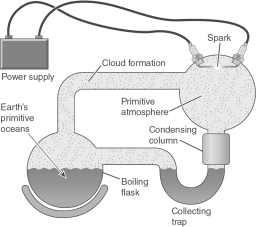


Unlock Deck
Unlock for access to all 100 flashcards in this deck.
Unlock Deck
k this deck
74
Explain why, in a self-replicating system (e.g., bacterial populations) in which a member would copy itself every minute, even mutations that have only a slim rate of occurrence could still significantly improve the survival chance of the system.

Unlock Deck
Unlock for access to all 100 flashcards in this deck.
Unlock Deck
k this deck
75
What is the origin of the atmospheric oxygen on Earth?

Unlock Deck
Unlock for access to all 100 flashcards in this deck.
Unlock Deck
k this deck
76
What are extremophiles, and how do they feature in the history of life on Earth?

Unlock Deck
Unlock for access to all 100 flashcards in this deck.
Unlock Deck
k this deck
77
Using the figure below, explain which types of events necessarily preceded the formation of our Solar System in order for the four main chemical elements of life to be present. 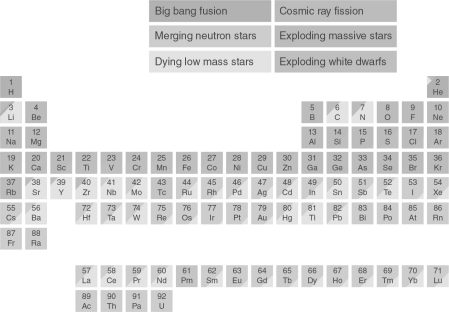


Unlock Deck
Unlock for access to all 100 flashcards in this deck.
Unlock Deck
k this deck
78
People argue against the possibility of time travel by saying, "If humans will eventually be able to travel back in time, then where are all the tourists from the future?" This idea is similar to
The ________, only applied to time travel instead of alien space travel.
A) Drake equation
B) cosmological principle
C) Fermi paradox
D) Urey-Miller experiment
E) evolutionary tree of life
The ________, only applied to time travel instead of alien space travel.
A) Drake equation
B) cosmological principle
C) Fermi paradox
D) Urey-Miller experiment
E) evolutionary tree of life

Unlock Deck
Unlock for access to all 100 flashcards in this deck.
Unlock Deck
k this deck
79
Explain why scientists think we are specifically made of star stuff, or, more poetically, that humans are the "children of stars."

Unlock Deck
Unlock for access to all 100 flashcards in this deck.
Unlock Deck
k this deck
80
What is the main impediment for interstellar travel?
A) the high cost of technology enabling travel at the speed of light
B) the fear of encountering hostile life-forms
C) a lack of international cooperation
D) that only unstable wormholes can be created with current technology
E) Current technology cannot produce the energy necessary to travel at high enough speeds to make interstellar travel worthwhile.
A) the high cost of technology enabling travel at the speed of light
B) the fear of encountering hostile life-forms
C) a lack of international cooperation
D) that only unstable wormholes can be created with current technology
E) Current technology cannot produce the energy necessary to travel at high enough speeds to make interstellar travel worthwhile.

Unlock Deck
Unlock for access to all 100 flashcards in this deck.
Unlock Deck
k this deck



